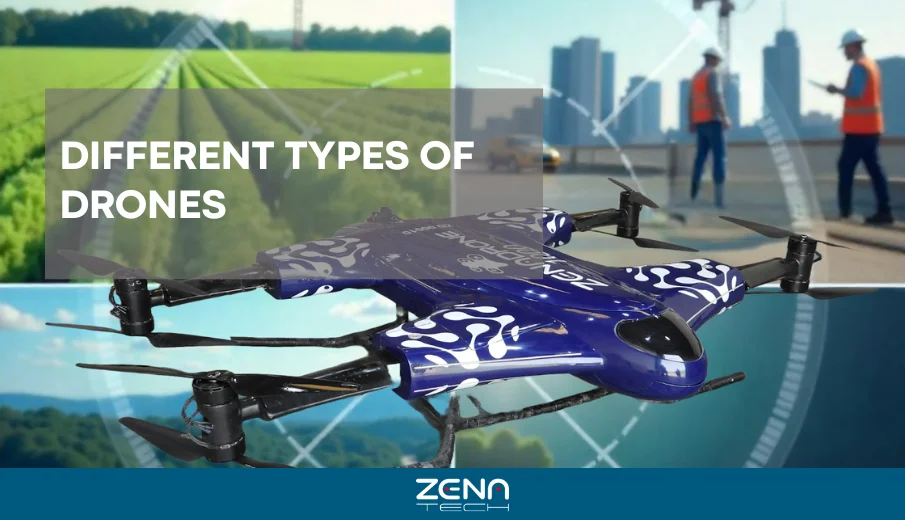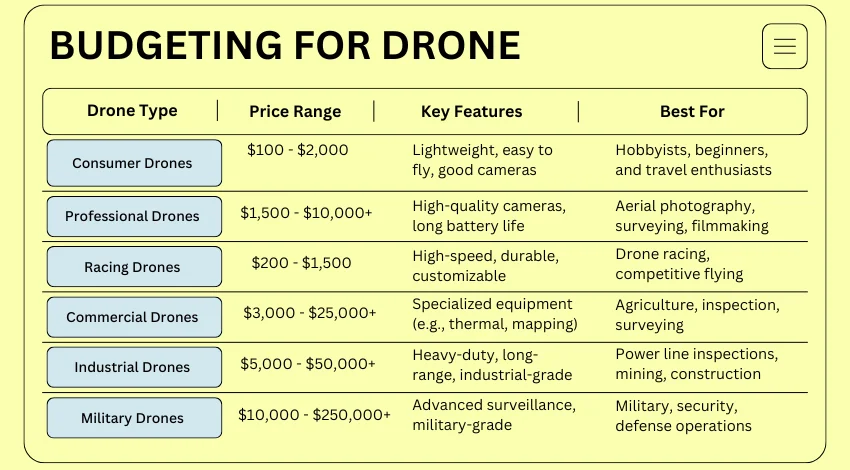
Drone technology has played a significant role in reshaping work operations. It can offer services such as aerial photography, military surveillance, and crop monitoring.
Discover the different types of drones. Explore drone classifications based on their features and use cases. So, whether you’re an enthusiast or a professional, you can find a suitable drone that suits your needs.
Why Understanding Drone Types Matters
Every type of drone functions in a specific manner. When you choose the wrong one, you could either reduce efficiency or, worse, incur higher costs.
If you are interested in drone services, whether for farming, security, or filmmaking, knowing the different types of drones can help you decide which one to choose. It can also lead to worthwhile investments and outcomes.
Here is a brief list of drone classifications for informational purposes.
Classification of Drones
Here is a breakdown of drone technology based on the following:
- Design and Flight Mechanics
- Uses and Purpose
- Range and Altitude
Comprehend the differences for easier identification of what to choose.
Drone Based on Design and Flight Mechanics
Multi-Rotor Drones
It is the most popular type of drone, especially for hobbyists and professionals. The type is known as easy to fly and control. However, it may have limited battery life since it usually consumes high power. It is commonly used for aerial photography, inspections, and surveillance.
Fixed-Wing Drones
This type typically resembles a traditional aeroplane. It also features a more extended flight range and increased endurance. Thus, it also requires a runway or launcher before it can take off and fly. It is ideal for tasks such as mapping, agriculture, and surveying large areas.
Single Rotor Helicopter
It features a helicopter-style design with more efficient functions than multi-rotor drones. Thus, the drone can carry payloads, making it ideal for industrial and military operations.
Hybrid VTOL (Vertical Take-Off and Landing)
This drone type combines fixed-wing and multi-rotor drones. It is ideal for complex missions as it can hover and fly long distances, and it is known for its endurance and flexibility.
Based on design, all these different types of drones may have varying performance due to their aerodynamic characteristics. A fixed-wing drone is more aerodynamic, which allows it to fly longer at high speeds. Meanwhile, a multi-rotor drone is less aerodynamic, whereas the drone pilot can have greater manoeuvrability and control, especially in narrow spaces.
Drone Based on Usage
Consumer Drones
This drone is popular among hobbyists and professionals. It is easy to use and usually has a plug-and-play design, which is why it is commonly used for recreational photography and video. However, as it is affordable, it can also have a short range or low battery life.
Commercial Drones
It is usually used for agriculture, logistics, and media industries. The drone offers a high payload capacity, extended battery life, reliable sensors, and seamless integration of drone software. It is commendable support for different aerial works.
Industrial Drones
This drone type is designed for demanding work and harsh environments. It is typically equipped with advanced sensors, GPS tracking, and an autonomous flight feature, making it ideal for tasks such as infrastructure inspection and construction monitoring.
Drones Based on Range and Altitude
Very Small Drones (Micro/Nano)
- Under 250 grams
- Limited to indoor or close-range use
- Popular for educational and toy applications
Short-Range Drones
- Range of about 1-5 kilometers
- Used for aerial photography and hobbyist flying
Medium-Range Drones
- Range of 5-50 kilometers
- Ideal for commercial inspections and monitoring
Long-Range Drones
- Over 50 kilometers of range
- Used in military operations, power line inspection, and search & rescue
Types of Military Drones
Military drones are in a league of their own. The different types of military drones include:
Tactical Drones
- Compact and easily deployable
- Used for surveillance and intelligence gathering
- Operated manually or via autonomous flight
Reconnaissance Drones
- Designed for long-endurance missions
- Provide real-time video feed and data
- Often used in border security and terrain mapping
Strategic Drones
- Operate at high altitudes for long durations
- Collect data over vast areas
- Offer global surveillance capabilities
Drone Types Comparison Table
Here is a comparison table of the different types of drones for easier understanding.
| Drone Type | Flight Time (Avg) | Range (Avg) | Typical Use |
| Multi-Rotor | 20-30 mins | 1-5 km | Photography, surveillance |
| Fixed-Wing | 1-2 hours | 50+ km | Mapping, agriculture |
| Single-Rotor | 30-60 mins | 10-30 km | Industrial, military |
| Hybrid VTOL | 45-90 mins | 20-100 km | Surveying, delivery |
| Nano/Micro Drones | 5-10 mins | <1 km | Toys, education |
| Tactical Military | 1-3 hours | 10-100 km | Reconnaissance |
| Strategic Military | 12-24 hours | 200+ km | Long-term surveillance |
Key Features of Drone Technology
1. Battery Life
Longer battery life means extended mission duration. Consumer drones typically last 20-30 minutes, while industrial models can last up to an hour. Hence, it is best to know the purpose of the drone operation.
2. Payload Versatility
The drone should be able to handle the weight of its equipment. Some of the typical payloads include cameras, sensors, or sprayers. It is better to know the drone’s payload capability.
3. Sensors and Cameras
Some of the usual drone sensors are gyroscopes, accelerometers, and thermal cameras. High-quality cameras with multispectral sensors can guarantee improved navigation, safety, and mission success.
4. Flight Range
As shown in the table earlier, each drone type has a different flight range. Knowing the purpose of the flight is essential to determining how long the flight operation will take and to identifying the ideal drone to use.
5. GPS Tracking and Navigation
Real-time GPS tracking and autonomous flight systems allow precise control, making them ideal for mapping, agriculture, and delivery services.
6. Drone Software
Modern drones rely heavily on drone software. Flight planning, data processing, and real-time monitoring depend on quality programs.
7. Drone Safety Protocols
Avoiding signal interference, performing drone calibration, and understanding environmental impact are essential. Always follow drone regulations and comply with all relevant requirements.
Use Cases for Different Drone Types
Here are some notable cases of drone use in various industries and operational contexts.
Photography and Videography
In this field, multi-rotor drones are the dominant type. They support operations with stable aerial photography and videography. Users can experience a real-time video feed and capture high-quality images with a camera. During the 2020 Tokyo Olympics, drones were extensively used for overhead shots and real-time broadcasting.
Farming and Agriculture
Fixed-wing drones cover large fields for mapping and crop monitoring. Payloads can include sensors for soil and moisture analysis, which are crucial for farming and agriculture.
Power Line Inspection
Industrial drones equipped with zoom cameras and thermal sensors safely inspect live wires and tall towers. For instance, Pacific Gas and Electric (PG&E) used drones after the 2018 California wildfires to assess and monitor damaged power lines.
Night Vision Drone and Surveillance
Military and police forces use drones with infrared sensors for nighttime missions. These types of drones operate silently and at high altitudes. Similar to U.S. Customs and Border Protection, in 2021, they used night-vision drones along the southern border for surveillance missions.
Traffic Management
Municipal authorities use drones to monitor traffic flow and road conditions. Short to medium-range drones excel in this role. In the 2022 FIFA World Cup, drones were used to monitor traffic and facilitate crowd control around stadiums.
Disaster Response
Long-range and hybrid VTOL drones deliver medical supplies or gather situational awareness in affected areas.
Environmental Conservation
Some drones support customizations for integrating sensors, drone software, and even maintenance tools. It addresses specific industry operations, such as wildlife tracking and environmental protection. For instance, in 2020, conservationists in Africa used drones with thermal sensors to track rhino movements and deter poachers.
Gas Powered Drone
Used in heavy-duty tasks where electric drones fall short. They offer longer flight times and higher power, but need more drone maintenance for gas power.
Drone Insurance Policies
Commercial and industrial drone users benefit from drone insurance policies. Coverage includes equipment damage, liability, and theft.
How to Plan Your Drone Budget?
Explore this table to understand the costs and features of different drones for your budget.
Drone Regulations and Compliance
Always check your local drone regulations. Many countries require certification for drones used in commercial operations. Registration, pilot licensing, and operational guidelines vary.
Drone safety protocols also include:
- Pre-flight drone calibration
- Signal interference checks
- Environmental impact assessments
Compliance with these rules protects people, property, and your drone.
Environmental Impact
While drones are more eco-friendly than helicopters or aeroplanes, they still have an environmental impact. Battery disposal, noise pollution, and wildlife disturbance must be taken into consideration.
Addressed this concern by opting for electrical drones or those with a reputable battery system. You can also invest in drones with quiet propulsion systems. That way, it can reduce environmental harm.
Final Thoughts
Different types of drones come with various functions and features. Whether it is a fixed-wing, VTOL, or consumer drone, each kind can provide a variety of advantages. Understand that each drone may offer a different purpose, including 4K-quality cameras, multispectral sensors, reliable GPS, and payload versatility.
With the proper understanding of these drone types, you can select the most suitable one. Experience enhanced productivity, reduced risk, and support sustainable operations. Ergo, whether you are into photography, agriculture, or military operations, there will always be a type of drone designed for you.
Explore Our Drone Solutions Now!
At Zena Tech, we offer comprehensive drone technology support tailored to diverse industries. Ready to elevate your operations with the suitable type of drone? Contact us today to learn more.


